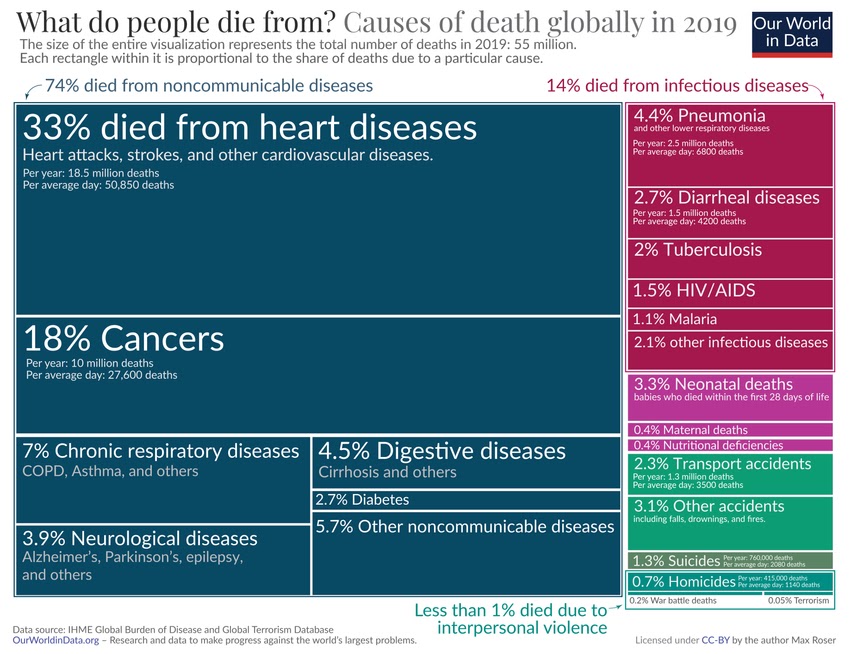Photo by davide ragusa on Unsplash
In the quest to safeguard public health and preserve lives, a fundamental question must be asked: What are people dying from? This inquiry serves as a compass, guiding our decisions in the realm of public health and propelling us toward life-saving solutions.
Yet, many of the leading causes of death often go unnoticed in mainstream discourse. If news reports were to reflect the stark reality of what children succumb to, the somber statistics would reveal approximately 1,400 young lives lost daily due to diarrheal diseases, 1,000 from malaria, and 1,900 from respiratory infections.
The good news is that change is possible. Over time, death rates stemming from these causes have shown a remarkable decline across the globe. This transformation owes itself to an improved understanding of the root causes of mortality. It has sparked the development of innovative technologies, preventive measures, and advancements in healthcare, significantly reducing the odds of succumbing to a wide array of afflictions, spanning all age groups.
In the not-so-distant past, infectious diseases held sway over the realm of mortality. However, death rates from these infectious maladies have plummeted, outpacing other causes of death. This shift has ushered in a new era where non-communicable diseases, such as heart diseases and cancers, reign as the predominant global culprits behind mortality.
The journey towards progress continues, and the impact of these causes of death can be further curtailed.
On this page, you will find comprehensive global data and research shedding light on the primary causes of death and strategies for prevention. This data encapsulates the number of lives claimed by each cause, their corresponding mortality rates, disparities across age groups, and evolving trends over time.
This wealth of information also provides invaluable insights into the broader burden of disease, offering a lens through which to examine the influences of healthcare and medicine, individual behaviors, environmental factors, health infrastructure, and more. On a global scale, non-communicable diseases remain the most prevalent contributors to mortality.
The accompanying chart, depicting global causes of death in 2019, is a stark illustration of this reality. Each box represents a distinct cause, with its size proportional to the number of lives it claimed.
The dominant causes, painted in blue, belong to the category of 'non-communicable diseases.' These encompass heart disease, cancer, and chronic respiratory ailments, typically progressing gradually over time and not transmitted between individuals. Heart diseases claim the ignominious title of the most frequent cause of death globally, responsible for a third of all mortalities. Cancers follow closely behind, accounting for nearly one-fifth of all deaths. Together, heart diseases and cancers are the harbingers of every other demise.
In red, we confront infectious diseases, responsible for approximately one-seventh of all deaths. This category encompasses pneumonia, diarrheal diseases, tuberculosis, HIV/AIDS, and malaria.
A smaller yet significant portion, roughly 4%, results from neonatal and maternal deaths, with a similar share attributed to accidents.
As we navigate the intricate web of global health, this data serves as both a roadmap and a clarion call to action. It beckons us to continue our pursuit of innovative solutions, fostering a world where the specter of preventable deaths recedes, and the promise of longer, healthier lives becomes a reality for all.
Preventable Tragedy: Millions of Young Lives Lost
A Glimpse into the Heartbreaking Reality of Child Mortality
Every child's life is a world of potential, a future filled with dreams and aspirations. Yet, tragically, millions of young children around the globe meet untimely deaths due to preventable causes. It's a heart-wrenching truth that we must confront. The scale of child mortality is nothing short of staggering, with five million children under the age of five succumbing to their fate each year. To put it in stark terms, that equates to roughly 14,000 innocent lives extinguished every single day.
Understanding the Harsh Reality
A visual representation in the chart provides a somber glimpse into what these young souls perish from. The size of each box on the chart corresponds to the number of children under five years old who lose their lives to each cause.
The most common causes of death for these young children differ significantly from the leading causes among the entire population, as revealed in previous insights.
Infectious Diseases Loom Large
Infectious diseases cast a dark shadow over these young lives, claiming an estimated 2.2 million children annually. Among these infectious killers are pneumonia, diarrheal diseases, malaria, and meningitis. These diseases, though formidable foes, are not invincible. With access to vaccination, basic medication, rehydration treatments, and nutrition supplementation, a substantial portion of these child deaths could be prevented.
Birth Disorders: A Silent Threat
Following closely behind infectious diseases are birth disorders, a silent yet devastating adversary. Preterm birth, neonatal asphyxia (suffocation), and trauma collectively contribute to an estimated 1.9 million child deaths. These tragedies underscore the critical importance of proper neonatal healthcare and timely interventions to ensure safe deliveries.
Unseen Culprits
Several other causes, including heart abnormalities and malnutrition, silently claim the lives of around 100,000 children each. These figures are astonishing, primarily because many of these causes are entirely preventable. Simple and cost-effective measures, such as vaccination campaigns, access to basic medical care, rehydration therapy, nutritional support, and comprehensive neonatal healthcare, hold the power to transform these statistics.
In the face of this heart-wrenching reality, there is hope. With concerted global efforts, increased access to healthcare, and a commitment to the well-being of every child, we can turn the tide. Let us stand together to ensure that no child's life is cut short by preventable causes, and that every young heart has the chance to flourish and fulfill its boundless potential.





